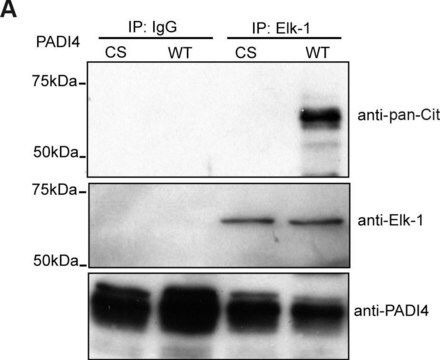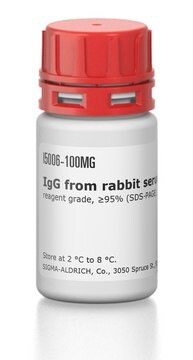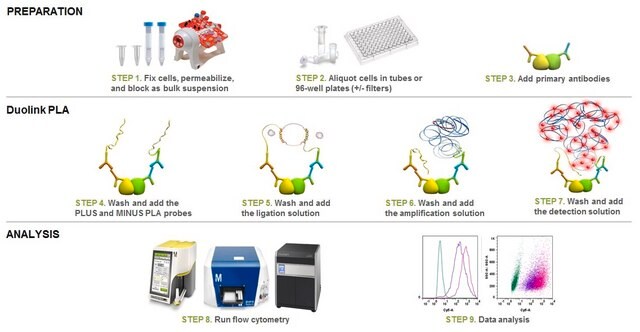DUO87004
Duolink® PLA Probe Rabbit IgG Isotype Control MINUS from rabbit
suitable for proximity ligation assay
Autenticatiper visualizzare i prezzi riservati alla tua organizzazione & contrattuali
About This Item
Prodotti consigliati
Origine biologica
rabbit (polyclonal)
Livello qualitativo
Forma dell’anticorpo
affinity purified immunoglobulin (Isotype control antibody)
Nome Commerciale
Duolink®
tecniche
proximity ligation assay: suitable
Compatibilità
suitable for brightfield
suitable for fluorescence
Condizioni di spedizione
wet ice
Temperatura di conservazione
2-8°C
Descrizione generale
An immunoglobulin G (IgG) isotype control antibody with the Duolink PLA MINUS oligonucleotide specific for rabbit IgG. This is a convenience product to be used in place of a rabbit primary antibody to determine non-specific background signal and optimal antibody dilution. The anti-rabbit PLA probe MINUS is not necessary when using this product, but must be used in combination with a PLUS PLA probe.
Applicazioni
Duolink® proximity ligation assay(PLA®) allows for endogenous detection of protein interactions, post translational modifications, and protein expression levels at the single molecule level in fixed cells and tissue samples.
This product can be applied to both the Duolink® In Situ Fluorescence Protocol and the Duolink® In Situ Brightfield Protocol depending on the detection reagents used.
Visit our Duolink® PLA Resource Center for information on how to run a Duolink® experiment, applications, troubleshooting, and more.
This product can be applied to both the Duolink® In Situ Fluorescence Protocol and the Duolink® In Situ Brightfield Protocol depending on the detection reagents used.
Visit our Duolink® PLA Resource Center for information on how to run a Duolink® experiment, applications, troubleshooting, and more.
Application Note
To perform a complete Duolink® PLA in situ experiment you will need two primary antibodies (PLA, IHC, ICC or IF validated) that recognize two target epitopes. Other necessary reagents include a pair of PLA probes from different species (one PLUS and one MINUS), detection reagents, wash buffers, and mounting medium. Note that the primary antibodies must come from the same species as the Duolink® PLA probes. Analysis is carried out using standard immunofluorescence assay equipment.HRP is also available for brightfield detection.
Isotype control PLA probes are used in lieu of a primary antibody in a Duolink® PLA in situ experiment to determine background signal contributed by non-specific binding of the primary antibody. Isotype control PLA probes can also be used to determine the optimal titer conditions of primary antibody PLA probes.
A PLUS probe of a different species must be used simultaneously with this product. See our Product Selection Guide for more information.
Let us do the work for you, learn more about our Custom Service Program to accelerate your Duolink® projects
View full Duolink® product list
To perform a complete Duolink® PLA in situ experiment you will need two primary antibodies (PLA, IHC, ICC or IF validated) that recognize two target epitopes. Other necessary reagents include a pair of PLA probes from different species (one PLUS and one MINUS), detection reagents, wash buffers, and mounting medium. Note that the primary antibodies must come from the same species as the Duolink® PLA probes. Analysis is carried out using standard immunofluorescence assay equipment.HRP is also available for brightfield detection.
Isotype control PLA probes are used in lieu of a primary antibody in a Duolink® PLA in situ experiment to determine background signal contributed by non-specific binding of the primary antibody. Isotype control PLA probes can also be used to determine the optimal titer conditions of primary antibody PLA probes.
A PLUS probe of a different species must be used simultaneously with this product. See our Product Selection Guide for more information.
Let us do the work for you, learn more about our Custom Service Program to accelerate your Duolink® projects
View full Duolink® product list
Caratteristiche e vantaggi
- No overexpression or genetic manipulation required
- High specificity (fewer false positives)
- Single molecule sensitivity due to rolling circle amplification
- Relative quantification possible
- No special equipment needed
- Quicker and simpler than FRET
- Increased accuracy compared to co-IP
- Publication-ready results
Note legali
Duolink is a registered trademark of Merck KGaA, Darmstadt, Germany
PLA is a registered trademark of Merck KGaA, Darmstadt, Germany
Codice della classe di stoccaggio
12 - Non Combustible Liquids
Classe di pericolosità dell'acqua (WGK)
WGK 2
Punto d’infiammabilità (°F)
Not applicable
Punto d’infiammabilità (°C)
Not applicable
Certificati d'analisi (COA)
Cerca il Certificati d'analisi (COA) digitando il numero di lotto/batch corrispondente. I numeri di lotto o di batch sono stampati sull'etichetta dei prodotti dopo la parola ‘Lotto’ o ‘Batch’.
Possiedi già questo prodotto?
I documenti relativi ai prodotti acquistati recentemente sono disponibili nell’Archivio dei documenti.
Il team dei nostri ricercatori vanta grande esperienza in tutte le aree della ricerca quali Life Science, scienza dei materiali, sintesi chimica, cromatografia, discipline analitiche, ecc..
Contatta l'Assistenza Tecnica.






